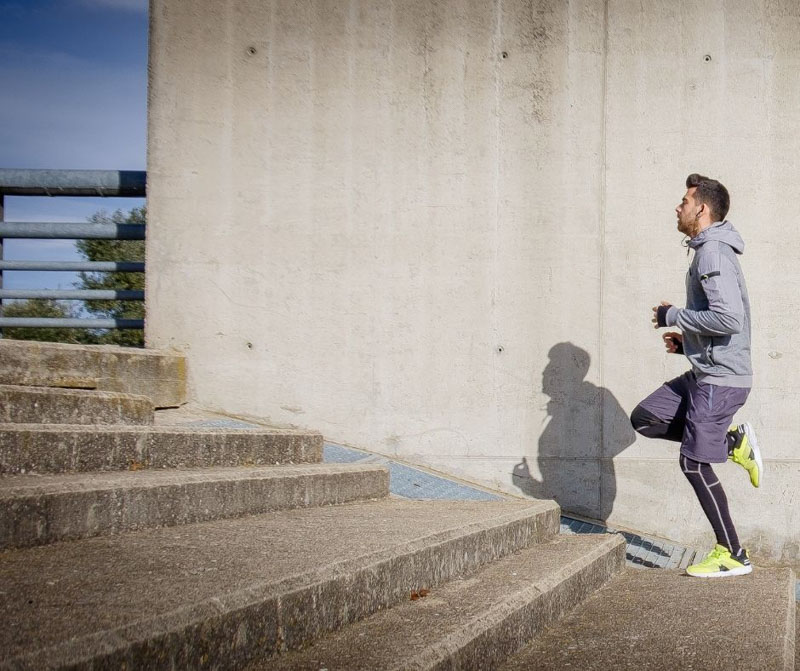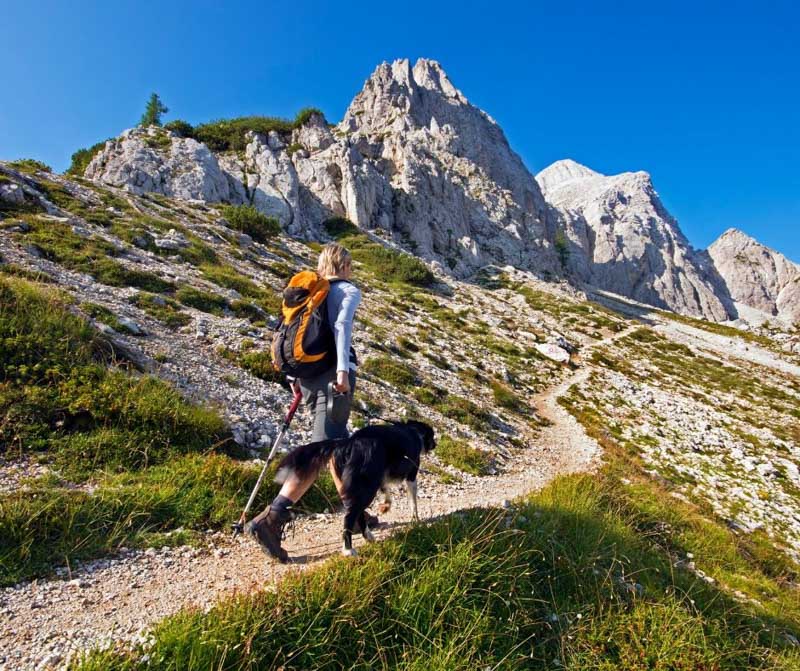Strength training is an important part of preparing for your hiking trip. You’re likely working on your cardio, but are you ignoring this important part of your training?
You’ve reserved your big hiking trip, like the Self-Guided Tour du Mont Blanc, Alta Via 1 or one of the other hiking tours that we offer. Strength training is what you need before you get all excited to take in all the splendid views! But you want to be sure that you’re fit enough to actually enjoy those views.
That’s why it’s so important to prepare for your big hike. There are various forms of strength training for a short and extended period of time, and I’ve got the perfect hiking training plan for you.
Before getting started with any new fitness plan it’s always good to have a medical check-up. This is to avoid the risk of injury and know your starting position before strength training.
If you have any old nagging injuries, get these assessed by your doctor or physiotherapist. Your body will thank you and you’ll know how to get your muscles stronger too.
Recommended Reading: Best Walking Holidays in Italy

It’s important to take these small aches and pains into account when training for hiking. Depending on your body weight, body fat, muscle mass and strength training goals you’ll need to consider the amount of time you have to train before hiking a trail.
If you have any joint pain/injury (ankles, knees or shoulders) it is imperative that you seek professional advice in advance. You won’t want your quality of life and damage your muscles be affected just because of one hike.
You’ll want to ensure that you work specifically to increase muscle strength in those areas to prevent any serious problems during your hiking trip and decrease your risk of fracture and muscle damage.
Hiking poles will take some of the pressure off your joints but you’ll still want to strengthen these areas before.
Besides getting you ready to take on that big hike, strength training also has other great health benefits like increasing your cardiovascular health and bone density.
It’s important to take these small aches and pains into account when training for hiking. Depending on your body weight, body fat, muscle mass and strength training goals you’ll need to consider the amount of time you have to train before hiking a trail.
If you have any joint pain/injury (ankles, knees or shoulders) it is imperative that you seek professional advice in advance. You won’t want your quality of life and damage to your muscles to be affected just because of one hike.
You’ll want to ensure that you work specifically to increase muscle strength and not just do cardio for weight loss. Strength training in those areas to prevent any serious problems during your hiking trip and decrease your risk of fracture and muscle damage is a priority.
Hiking poles will take some of the pressure off your joints but you’ll still want to strengthen these areas before.
Besides getting you ready to take on that big hike, strength training also has other great health benefits like increasing your cardiovascular health and bone density.
How to Train for a Hike When You Don’t Live Near the Mountains

Now you might be asking yourself, how do I train for hiking when I do not live near a mountain nearly as big as where I plan on hiking? I have good news for you.
To prepare for hiking, strength training and resistance training can help with improvements of strength before your trip. The days per week of strength training can help you improve your body’s ability to handle the physical demands of hiking and make recovery easier.
There are many ways to prepare and various methods of strength training. The first step is mapping out just how many weeks you have left until your trip. Then determine how many hours per week and days per week you have to dedicate in order to meet your goal.
Get motivated and stay active by incorporating small physical activities in your everyday activities. If your goal is to lose some body weight or increase your metabolic rate it may be helpful to consider tempo runs, higher-intensity strength training (HIIT) training and strength training sessions.
If it’s keeping fit, increasing lean muscle mass a jog on the spot or a stationary bike or weight training could be handy. But sometimes the best way to get started is just to set yourself a realistic goal for how long you wish to work out. Set yourself challenges like ‘I will increase my hours of cardio every week’ or ‘I will focus on my progressive exercise training this month”
Resistance training is also a great way to improve strength and your metabolic rate in the comfort of your own home. This method of strength training involves the help of resistance bands. These are the go-to equipment for improvement of strength, power, and muscle tone. Unlike free weights that attach to a bench, resistant bands require zero space to work out. A favorite amongst strength trainers too!
Related Reading: Southern Via Dinarica in Montenegro, Albania & Kosovo
Here are some ways that you can train for your hike:

-
- Plan on walking 3 – 5 times per week. Vary your speed and distances. Be sure to include long-distance and brisk walks – this could be part of your daily activities. If possible take the hilliest routes in your area. Consider bringing a backpack with you so that you can get accustomed to carrying weight. Each week can add more weight to your pack – this also helps to train your upper body. Ideally use the same backpack that you’ll use when hiking so that you get used to it.
- Take the stairs. This is important not only to build your cardiovascular endurance but will also strengthen your quads which will help you with the ascents throughout your hike.
- BUILD YOUR CORE! It’s a major muscle but is often overlooked. Abdominal crunches are a go to for homework outs. Having a strong core (I’m not just talking six-pack abs) will help you more than you think. When carrying a heavy backpack and as fatigue sets in, a strong core foundation is invaluable to get you up the mountain.
- If you have a gym membership, take advantage of the incline setting on the treadmill and the stair climber. Look for other equipment geared towards building leg strength and getting your heart rate up. Progressive resistance training with the use of resistance bands doesn’t hurt.
It is important that you get in the miles on your feet. Whenever possible use the same hiking boots you plan to wear on your trip. If you plan on getting new ones, now is the time to break them in. Make sure to buy light weight hiking shoes with ample cushioning
Related Reading: HIking for Beginners: How to Have an Amazing Day
Strength Training Exercises for Hikers

Depending on how much time you have on hand add the methods of strength training you want to incorporate in your everyday activities to round out your training, here is what you should prioritize in order to get the biggest bang for your buck.
Leg strength is paramount for hiking. If you have wobbly legs your hike will feel very long and difficult and not enjoyable. And you want to enjoy this. Many of these workouts can be done with bodyweight alone or with weights. This is where resistance training really comes in handy.
Resistance exercise training increases muscle strength by making your muscles work against a weight or force. A resistance exercise is an activity where you use your own body weight to challenge your muscles. For example, in push-ups you are challenging your arms and chest muscles. If you don’t use enough weight, it’s easy to get bored with this type of exercise and not see results that is why progressive resistance trainings should be part of your daily activities.
Don’t be afraid to start with a lighter weight and work your way up. You can see photos and more explanations of each of the exercises mentioned below by clicking here.
Related Reading: Greek Cyclades Islands of Tinos and Naxos Hiking Tour
Strength Training Leg Routine for Hikers:
Repeat this pyramid 2-4 times.
10 – Glute Bridges
20 – Reverse Lunges (10 each side)
30 – Squats
20 – Steps ups (10 each side)
10 – Side lunges (5 each side)
Related Reading: Coastal Hike: Costa Brava, Spain to France
Strength Training for Your Core (Important for Hikers)
Core strength is the foundation of your house. Without it, we would crumble forwards. These exercises will activate and reconnect you with your core (and were not just talking abdominal crunches):
Repeat this routine 2-4 times.
20 – Bird Dogs (10 each side)
15 – Overhead reaches (Deadbug if more advanced)
15 – Side plank with hip dips (knees bent or legs fully extended) (each side)
15 – Supermans
Related Reading: Gifts That Hikers Will Love
Strength Training for the Upper Body for Hikers
Last but not least, this routine targets your upper body, specifically your back and shoulders to build that much-needed strength when carrying your backpack all day. Note this plan is if you’re planning on carrying a day pack. If you’re planning on backpacking, see the plan below this section.
Repeat this routine 2-4 times.
10 – Cat cows
15 – Shoulder retractions
10 – Wall angels
15 – Push-ups
10 – Pike push-ups
30-second plank
It is also important that throughout your hiking preparation that you take time to stretch and rest. After each strength training session is sure that you stretch your quads, hamstrings, glutes, back, and arms. This is also a great way for muscle gain.
Muscle tightness can lead to imbalances and ultimately pain or injury. Be sure that you do no “overtrain” and that you include at least 1 full day of complete rest to allow your upper body to regenerate and recharge.
Related Reading: Alta Via 1 Hiking Tour in Dolomites Italy Entire, North or South Route
Preparing For Carrying A Backpack During Your Hike

First things first. Ensure that you choose the right backpack for your body type and the type of hike that you’ll be doing. You’ll find lots of great tips and recommendations in our article 13 Best Hiking Backpacks.
Strength Training Specifically For Backpacking
It’s important to strengthen your posterior chain, neck, and shoulders. Doing so will minimize aches and pains throughout your hike. Before we get into a specific backpack training program, let’s start with the most obvious way to train.
Carry a weighted backpack during your weekly training. Each week you can add additional weight to your pack in order to build up strength and endurance.
Related Reading: Tour du Mont Blanc Self-Guided Tours
Strengthening the “Posterior Chain”

Now let’s get back to that “posterior chain”. What’s that you ask? A posterior chain is a group of muscles comprised of the calves, hamstrings, gluteus muscles, multifidus, erector spinae, trapezius, and posterior deltoids.
This group of muscles is essential in keeping us erect and keeping our hips stable. More often than not we have an imbalance between the anterior chain and the posterior chain from an over-focus on quad and ab exercises like abdominal crunches.
This can lead to pain and weakness in our backs and our hips. So how does this tie into hiking? Carrying a heavy weight backpack for multiple days at a time is taxing on the body. And it’s especially taxing on your lower back, neck, and shoulders.
Related Reading: Croatia Hiking Tour: Split to Dubrovnik
Strength Training Workout for Backpackers

When you’re traveling, you’ll have to find time to work out. We’ve prepared some tips for when you’re on the road: Increase your cardio to long day hikes (60+ minutes each) with a pack that weighs about 80% of the weight you’ll be carrying on your trip. Also add a fourth day-hike training session to one of your strength training days. One or two days prior to your trip: Ease up on all strength training and resistance training, but keep workout routine relatively simple by incorporating easy walking between sets and resting more often between hard runs. This keeps your metabolic rate and blood pressure on peak for your next hike.
Here are some simple exercises that you can incorporate into the above hiking training program.
You can see photos and more explanations of each of the exercises mentioned below by clicking here:
– Good mornings or Romanian deadlifts
– Glute bridges
– Hip thrusters
– Kettlebell swings
– Bent over rows or cable pull-throughs
– Calf raises
– Wall angels
When trying to go on a hike and become a more fit you need to be prepared. The best way to get ready for the hike is to gain muscle tissue, improve body composition and muscle gain. Muscle tissue is simply the part of the body that gets stronger when you work out. With that in mind, people who train for long periods of time tend to develop a greater amount of muscle tissue within their bodies. In order to gain muscular strength and size, one must first have enough muscle tissue to begin with. Whatever types of strength training you do ensure that you do the stretches listed above when you’re finished.
Hiking can bring you to the most marvelous and wondrous places but having a weak back can ruin the experience. These different types of strength training and this recommended work out routine, you will be well on your way to ensuring you are prepared to take on the mountains!
By doing cardio and strength training you’ll be ready for your hiking trip and you’ll minimize your chance of injury and fatigue. Most importantly, you’ll feel good and enjoy your multi-day hike!
Amanda Isaac is a certified Personal Trainer and Nurse based in Munich, Germany. She specializes in core and pelvic floor training and provides one to one training. Get your free “Core Foundations” program by subscribing to the newsletter at https://www.amandaisaaccoaching.com/subscribe.

